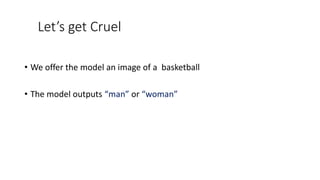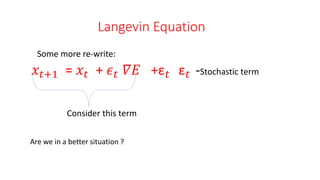Bayesian Neural Networks
- 1. Bayesian Neural Network Natan Katz Natan.katz@gmail.com
- 2. Agenda • Short Introduction to Bayesian Inference • Variational Inference • Bayesian Neural Network • Numerical Methods • MNIST Example
- 4. Bayesian Inference The inputs: Evidence – A Sample of observations (numbers, categories, vectors, images) Hypothesis - An assumption about the prob. structure that creates the sample Objective : We wish to learn the optimal parameters of this distribution. • This probability is called Posterior . • We wish to find the optimal parameters for P(H|E) • Remark In many books it is called MAP (Maximum A postriori Estimation)
- 5. Let’s Formulate Z- R.V. that represents the hypothesis X- R.V. that represents the evidence Bayes formula: P(Z|X) = 𝑃(𝑍,𝑋) 𝑃(𝑋)
- 6. Let’s Formulate (Cont.) 𝑃𝑟(Z) –Prior (The parameters’ distribution according to our belief) 𝑃𝑙(X|Z) –Likelihood (How likely is the sample given the parameters) P(Z|X) = 𝑃𝑟(z) 𝑃 𝑙(x|z) 𝑃(𝑋) Bayesian inference is therefore about working with the RHS terms. In some case studying the denominator is intractable or extremely difficult to calculate.
- 7. Example -GMM We have K Gaussians with known variance σ Draw μ 𝑘 ~ 𝑁 0, τ (τ is positive) from the prior For each sample j =1…n 𝑧𝑗 ~Cat (1/K,1/K…1/K) 𝑥𝑗 ~ 𝑁(μ 𝑧 𝑗 , σ) p(𝑥1….𝑛) = μ1:𝑘 𝑙=1 𝐾 𝑃(μ𝑙) 𝑖=1 𝑛 𝑧 𝑗 𝑝( 𝑧𝑗) P(𝑥𝑖|μ 𝑧 𝑗 ) => 𝑃𝑟𝑒𝑡𝑡𝑦 𝑆ℎ𝑖𝑡
- 8. Some Good news P(Z|X) = 𝑃𝑟(z) 𝑃 𝑙(x|z) 𝑃(𝑋) • We wish to learn Z • There is no Z in the denominator => P(Z|X) α 𝑃𝑙 𝑋 𝑍 𝑃𝑟(𝑍)
- 9. Solutions Until 1999 Mostly numerical sampling: • Metropolis Hastings • RBM
- 11. “AN INTRODUCTION TO VARIATIONAL METHODS FOR GRAPHICAL MODELS” 11
- 12. VI – Algorithm Overview • Rather a numerical sampling method we provide an analytical one: 1. We define a distribution family Q(Z) (bias-variance trade off) 2. We minimize KL divergence min KL(Q(z)|| P(Z|X)) log(P(X)) = 𝐸 𝑄 [log P(x, Z)] − 𝐸 𝑄 [log Q(Z)] + KL(Q(Z)||P(Z|X)) ELBO-Evidence Lower Bound • Maximizing ELBO =>minimizing KL
- 13. 𝐸𝐿𝐵𝑂 = 𝐸 𝑄[log P(X, Z)] − 𝐸 𝑄 [log Q(Z)] = 𝑄𝐿𝑜𝑔( 𝑃(𝑋,𝑍) 𝑄(𝑍) )= J(Q)- Euler Lagrange MFT (Mean Field Theory) Scientific “approval” 13
- 14. What Deep Learning doesn’t do
- 15. A DL Scenario • We train a CNN to identify images (men versus women) • Our accuracy can be amazing (98-99%) Pretty cool
- 16. Let’s get Cruel • We offer the model an image of a basketball • The model outputs “man” or “woman”
- 17. Why is that? Mathematical Observation We trained a function F such that F : {space of images}->{“man”,”woman”} Statistical Observation Basketball image is out of our training data
- 18. Anecdotes Image (Uri Itay) • Researchers trained a network to classify tanks and trees. After using 200 images (100 of each kind 50 train 50 test), the test accuracy was 100% . As they took it to the Pentagon it began to miss. The reason was that all the tank images were taken in cloudy days whereas trees in sunny. Text • We can see in text problems many cases where rather finding latent phenomena networks use words as their anchor.
- 19. A plausible corollary When we train a DL model: • We hardly ever know what the model learned • Models cannot “report” about their uncertainties
- 20. Is it crucial ? • Consider an engine that decides upon AI whether a tumor is malignant or benign • Drug treatment upon medical record • Actions that are taken by an autonomous vehicle • High frequency trading
- 21. What can we do? • DL models are trained to the optimal weights • What if rather training weights pointwise, we ill train weights’ distributions? The Inference • For each data pair (x,y) we create mean and variance • This variance will reflect model’s uncertainty • DL approach – Do Dropout in inference
- 22. Uncertainty Types Epistemic Uncertainty : Episteme= Knowledge Uncertainty that theoretically we can know but we don’t: • Model structure issues • Absence of data We can use the notion “reducible” too
- 23. Uncertainty Types Aleatoric Uncertainty : Aleator = Dice Player Uncertainty that we cannot solve: • The stochasticity of a dice • Noisy labels We can use the notion “irreducible” too
- 25. BNN-Training • We have a neural network • We place a prior distribution P over the weights W • For data D={ (X,Y)} For measuring uncertainties, we use the posterior Distribution
- 26. DL Vs. BNN DL 1. Training using a loss that is related to prediction probability P(Y|X,W) 2. The weights W are trained point-wise with MLE Bayesian NN 1. Training using a loss that is related the posterior probability P(W|X,Y) 2. We train weights’ distribution
- 27. BNN-Inference Inference We assume prior knowledge on the weights’ distribution π As in any NN we get an input x’ and aim to predict y’ : P(y’| x’) = 𝑃 y’ 𝑥′ , 𝑤 𝑃 𝑤 𝐷 𝑑𝑤 This can be rewritten as: P(y’| x’) =𝐸 𝑃(𝑤|𝐷) 𝑃 y’ 𝑥′ , 𝑤 D={(X,Y)}
- 28. Measuring Uncertainty • In the inference, given a data point 𝑥∗ • Sample weights W 𝑛 𝑡𝑖𝑚𝑒𝑠 • Calculate its statistics E[f(𝑥∗ ,w)]= 𝑖=1 𝑛 𝑓(𝑥∗ , 𝑤𝑖) V([f(𝑥∗ ,w)] =E𝑓(𝑥∗ ,w)2 - E[f(𝑥∗ ,w)]2 W –r.v. which 𝑤𝑖 is its samples
- 29. Common tools to obtain Posterior Dist. 1. Variational Inference 2. MCMC –Sampling (Metropolis –Hastings, Gibbs) 3. HMC 4. SGLD
- 30. Metropolis Hastings • MCMC sampling algorithm • The main idea is that we pick samples upon pdf comparisons: At each step we accept or randomize a sample upon the previous sample and decide to accept or reject • Unbiased, Huge variance and very slow (iterate over the entire data) • Great History
- 32. What is Hamiltonian? • A physical operator that measures energy of a dynamical system Two sets of coordinates q -State coordinates p- Momentum H(p, q) =U(q) +K(p) U(q) = log[π 𝑞 𝐿(𝑞|𝐷)] K(P)= 𝑝 2 2𝑚 U-Potential energy, K –Kinetic 𝑑𝐻 𝑑𝑝 = 𝑞 , 𝑑𝐻 𝑑𝑞 = - 𝑝
- 33. Hamiltonian Monte Carlo • Hamiltonians offer a deterministic vector field (with trajectories….) • If we set a Hamiltonian depended distribution, we can use this property for sampling P(x,y) = 𝑒−𝐻(𝑥,𝑦)
- 34. Hybrid - MC • We have the “state space” x • We can add “momentum” and use Hamiltonian mechanism Leap Frog Algorithm We set a time interval δ, For each step i : 1. 𝑃𝑖(t+0.5 δ) =𝑃𝑖(t) – (δ/2) 𝑑𝑈 𝑑𝑞(𝑡) 2 𝑄𝑖(t+ δ ) = 𝑄𝑖(t) + δ 𝑑𝐾 𝑑𝑝(𝑡+0.5δ) 3 𝑃𝑖(t+ δ) = 𝑃𝑖(t+0.5 δ) - (δ/2) 𝑑𝑈 𝑑𝑞(𝑡+δ) 𝑄𝑖 𝑄
- 35. HMC Algorithm (Neal 1995, 2012, Duane 1987) 1. Draw 𝑥0 from our prior Draw 𝑝0 from standard normal dist. 2. Perform L steps of leapfrog 3 Pick the 𝑥 𝑡 following M.H.
- 37. HMC –Pros & Cons Pros • It takes points from a wider domains thus we can describe the distribution better • It may take points with lower density • Faster than MCMC Cons • It may suffer from low energy barrier • No minibatch –Not nice • It has to calculate gradients for the entire data!!! Bad
- 38. What do we need then? • A tool that allows sub-sampling • Fewer Gradients • Keen knowledge about extremums and escape rooms
- 40. Langevin Equation Langevin Equation describes the motion of pollen grain in water: F -γ𝑣 𝑡 +ξ 𝑡=0 ξ 𝑡 ~N(0,t) ξ 𝑡 is a Brownian Force- The collisions with the water molecules F - External forces This equation has an equilibrium solution which is our posterior distribution
- 41. Langevin Equation Let’s use the following: F=𝛻𝐸 𝑣 𝑡 = 𝑑𝑋 𝑑𝑇 The eq in its discrete form becomes: 𝑥𝑡+1 = 𝑥𝑡 + dt γ ξ 𝑡 + 𝛻𝐸 dt γ (looks familiar doesn’t it?)
- 42. Langevin Equation Some more re-write: 𝑥𝑡+1 = 𝑥𝑡 + 𝜖 𝑡 𝛻𝐸 +ε 𝑡 ε 𝑡 -Stochastic term Consider this term Are we in a better situation ?
- 43. Robbins & Monro (Stoch. Approx. 1951) • Let F a function and θ a number • There exists a unique solution : F(𝑥∗ ) = θ F - is unknown Y - A measurable r.v. E[Y(x)] = F(x)
- 44. Robbins & Monro (cont) The following algorithm converges to 𝑥∗ : 𝑋 𝑁+1 = 𝑋 𝑁 +α 𝑁 (𝑌𝑁 − θ )
- 45. Back to Langevin 𝑥 𝑡+1 = 𝑥 𝑡 + 𝜖 𝑡 𝛻𝐸 +ε 𝑡 𝛻𝐸 𝑚𝑏=𝛻𝐸 + ε 𝑡 𝑥 𝑡+1 = 𝑥 𝑡 + 𝜖 𝑡 𝛻𝐸 𝑚𝑏 Δ 𝜃𝑡 =ε 𝑡(𝛻log 𝑝 𝜃𝑡 + 𝑁 𝑛 𝑖=1 𝑁 𝛻log 𝑝 𝑥𝑖|𝜃𝑡 )
- 46. We are almost there • This eq converges to an optimal solution (MAP). • We need a solution of SDE (probability) • Let’s add a stochastic term Δ 𝜃𝑡 =ε 𝑡(𝛻log 𝑝 𝜃𝑡 + 𝑁 𝑛 𝑖=1 𝑁 𝛻log 𝑝 𝑥𝑖|𝜃𝑡 ) + η 𝑡 η 𝑡~N(0,σ)
- 47. Variance Analysis ε 𝑡 - Follow R&M rules How big is σ ? Bigger than ε 𝑡 *V(𝛻) As t->∞ the equation must become Langevin. THE variance of η must be therefore bigger than ε 𝑡 *V(𝛻)
- 50. Problem’s Framework • MNIST CNN model • MNIST SOTA ~99.8%
- 51. The Experiment • Training a BNN – using VI (small amount, of epochs) • Set a regular decision law – Take the max score of each digit =>Accuracy ~88%
- 52. Allowing the Network to refuse • For each image: • Sample 100 networks • We obtain 100 outputs per image • We have 10 digits each with 100 scores • If the median of these 100 scores>0.2 we take (Indeed, we can accept more than one result)
- 57. Random Image
- 58. Summary • Accuracy 96% • Refuse 12.5% • Random images 95% have been refused
- 59. Thanks!!
- 60. My process • https://wjmaddox.github.io/assets/BNN_tutorial_CILVR.pdf • https://arxiv.org/pdf/2007.06823.pdf • https://towardsdatascience.com/what-uncertainties-tell-you-in-bayesian-neural-networks-6fbd5f85648e • https://medium.com/@uriitai/augmentation-and-groups-theory-795c287fec3f • https://github.com/paraschopra/bayesian-neural-network-mnist/blob/master/bnn.ipynb • https://towardsdatascience.com/making-your-neural-network-say-i-dont-know-bayesian-nns-using-pyro- and-pytorch-b1c24e6ab8cd • http://www.stats.ox.ac.uk/~teh/research/compstats/WelTeh2011a.pdf • https://arxiv.org/pdf/1206.1901.pdf • http://cgl.elte.hu/~racz/Stoch-diff-eq.pdf • https://arxiv.org/ftp/arxiv/papers/1103/1103.1184.pdf • https://henripal.github.io/blog/langevin • https://www.cs.princeton.edu/courses/archive/fall11/cos597C/lectures/variational-inference-i.pdf











![VI – Algorithm Overview
• Rather a numerical sampling method we provide an analytical one:
1. We define a distribution family Q(Z) (bias-variance trade off)
2. We minimize KL divergence min KL(Q(z)|| P(Z|X))
log(P(X)) = 𝐸 𝑄 [log P(x, Z)] − 𝐸 𝑄 [log Q(Z)] + KL(Q(Z)||P(Z|X))
ELBO-Evidence Lower Bound
• Maximizing ELBO =>minimizing KL](https://image.slidesharecdn.com/bnn6-201217144233/85/Bayesian-Neural-Networks-12-320.jpg)
![𝐸𝐿𝐵𝑂 = 𝐸 𝑄[log P(X, Z)] − 𝐸 𝑄 [log Q(Z)] = 𝑄𝐿𝑜𝑔(
𝑃(𝑋,𝑍)
𝑄(𝑍)
)= J(Q)- Euler Lagrange
MFT (Mean Field Theory)
Scientific “approval”
13](https://image.slidesharecdn.com/bnn6-201217144233/85/Bayesian-Neural-Networks-13-320.jpg)














![Measuring Uncertainty
• In the inference, given a data point 𝑥∗
• Sample weights W 𝑛 𝑡𝑖𝑚𝑒𝑠
• Calculate its statistics
E[f(𝑥∗
,w)]= 𝑖=1
𝑛
𝑓(𝑥∗
, 𝑤𝑖)
V([f(𝑥∗
,w)] =E𝑓(𝑥∗
,w)2
- E[f(𝑥∗
,w)]2
W –r.v. which 𝑤𝑖 is its samples](https://image.slidesharecdn.com/bnn6-201217144233/85/Bayesian-Neural-Networks-28-320.jpg)



![What is Hamiltonian?
• A physical operator that measures energy of a dynamical system
Two sets of coordinates
q -State coordinates
p- Momentum
H(p, q) =U(q) +K(p)
U(q) = log[π 𝑞 𝐿(𝑞|𝐷)] K(P)=
𝑝 2
2𝑚
U-Potential energy, K –Kinetic
𝑑𝐻
𝑑𝑝
= 𝑞 ,
𝑑𝐻
𝑑𝑞
= - 𝑝](https://image.slidesharecdn.com/bnn6-201217144233/85/Bayesian-Neural-Networks-32-320.jpg)










![Robbins & Monro (Stoch. Approx. 1951)
• Let F a function and θ a number
• There exists a unique solution :
F(𝑥∗ ) = θ
F - is unknown
Y - A measurable r.v.
E[Y(x)] = F(x)](https://image.slidesharecdn.com/bnn6-201217144233/85/Bayesian-Neural-Networks-43-320.jpg)
















